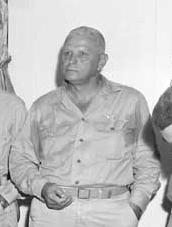![]() The Pacific War Online Encyclopedia
The Pacific War Online Encyclopedia
|
| Previous: Gearing Class, U.S. Destroyers | Table of Contents | Next: Gemas |

National Archives #80-G-235994
Cropped by author
"Rugged Roy" Geiger was born in Florida and graduated from John B. Stetson University in 1907. He was very briefly a lawyer before joining the Marines as an enlisted man in November 1907. Two years later he was commissioned. He saw service in Latin America, the Philippines, and China as well as at sea. He was the fifth Marine officer to complete flight training, in 1917. By 1918, he was leading a bomber squadron in Europe.
Between the wars Geiger was active in developing both aerial and amphibious doctrine. He was a graduate of the Army Command and General Staff School (1925) and the Army War College (1929). He was selected to participate in the Grand Conference that reviewed the Tentative Manual for Landing Operations in December 1933, and he attended and the Navy War College in 1941.
The attack on Pearl
Harbor
found Geiger recently promoted to brigadier general and in command of
1
Marine Aircraft Wing on the East
Coast. He
led his wing
into combat at Guadalcanal
before being promoted to major general and serving for a
time as director of Marine aviation in Washington. Late in
1943 he received
another field command, this time with I
Marine Amphibious Corps,
which
was later redesignated III
Amphibious Corps and fought at Guam,
Peleliu,
and Okinawa. When 10
Army
commander Simon
Bucker
was killed at Okinawa,
Geiger was the next senior officer and thereby became the only Marine
officer
ever to command a field army. In July he relieved Holland Smith as Commander, Fleet
Marine Force, Pacific. He died shortly before he was scheduled to
retire, and was posthumously awarded the rank of full general.
Spruance
described
Geiger as "born brave." Frank (1990) describes him as "Stern, curt,
even ruthless". Smith (2000) describes him as having "the temperament
and appearance of a Roman emperor". Geiger was a strong proponent of
air support for ground
operations and a hard driver who once shamed reluctant pilots on
Guadalcanal to make
greater efforts by personally piloting an SBD to dive-bomb a Japanese position. He also had no
tolerance for interservice rivalry, and saw to it that his Marines
worked effectively with 77 Division
on Guam and 81
Division on Peleliu.
| 1885-1-25 |
Born at Middleburg, Florida |
|
| 1907 |
Graduates from Stetson
University, Florida |
|
| 1907-11-2 |
Enlists in the Marine Corps |
|
| 1909-2-6 |
Second
lieutenant |
Commissioned in the Marine
Corps. Assigned to Wisconsin. |
| 1912-8 |
Service in Nicaragua |
|
| 1913 |
American Legation, China |
|
| 1916-3-31 |
First lieutenant |
Flight training |
| 1917-12-15
|
Captain |
Commander, Aeronatic Detachment |
| 1918-7 |
1 Marine Aviation Force |
|
| 1924 |
Command and General Staff SchoolHolland Smith | |
| 1928 |
Army War College |
|
| 1931-11-6 |
Major |
Director of Marine Corps Aviation |
| 1940 |
Navy War College |
|
| 1941-8-20 |
Colonel |
Commander, 1 Marine Aircraft Wing |
| 1943-5-13 |
Major general |
Director of Marine Corps Aviation |
| 1943-11-9
|
Commander, I Marine Amphibious Corps | |
| 1944-4-15 |
Commander, III Amphibious Corps | |
| 1945-6-23 |
Interim commander, 10 Army | |
| 1945-7-3 |
|
Commander, Fleet Marine Force, Pacific |
| 1947 |
General |
Dies; posthumously promoted |
References
Naval Historical Center (accessed 2008-2-28)
The Pacific War Online Encyclopedia © 2007-2008, 2010 by Kent G. Budge. Index